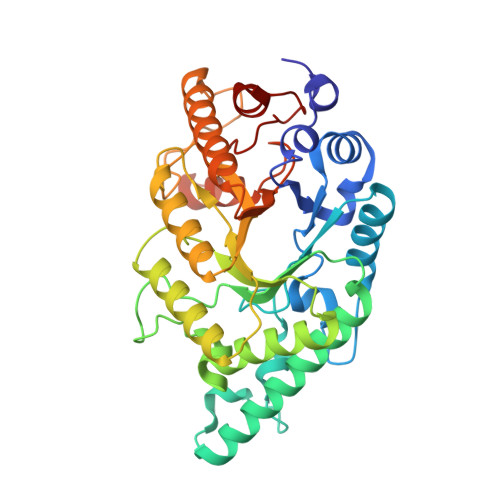Crystal structures of native and xylosaccharide-bound alkali thermostable xylanase from an alkalophilic Bacillus sp. NG-27: structural insights into alkalophilicity and implications for adaptation to polyextreme conditions.
Manikandan, K., Bhardwaj, A., Gupta, N., Lokanath, N.K., Ghosh, A., Reddy, V.S., Ramakumar, S.(2006) Protein Sci 15: 1951-1960
- PubMed: 16823036
- DOI: https://doi.org/10.1110/ps.062220206
- Primary Citation of Related Structures:
2F8Q, 2FGL - PubMed Abstract:
Crystal structures are known for several glycosyl hydrolase family 10 (GH10) xylanases. However, none of them is from an alkalophilic organism that can grow in alkaline conditions. We have determined the crystal structures at 2.2 Angstroms of a GH10 extracellular endoxylanase (BSX) from an alkalophilic Bacillus sp. NG-27, for the native and the complex enzyme with xylosaccharides. The industrially important enzyme is optimally active and stable at 343 K and at a pH of 8.4. Comparison of the structure of BSX with those of other thermostable GH10 xylanases optimally active at acidic or close to neutral pH showed that the solvent-exposed acidic amino acids, Asp and Glu, are markedly enhanced in BSX, while solvent-exposed Asn was noticeably depleted. The BSX crystal structure when compared with putative three-dimensional homology models of other extracellular alkalophilic GH10 xylanases from alkalophilic organisms suggests that a protein surface rich in acidic residues may be an important feature common to these alkali thermostable enzymes. A comparison of the surface features of BSX and of halophilic proteins allowed us to predict the activity of BSX at high salt concentrations, which we verified through experiments. This offered us important lessons in the polyextremophilicity of proteins, where understanding the structural features of a protein stable in one set of extreme conditions provided clues about the activity of the protein in other extreme conditions. The work brings to the fore the role of the nature and composition of solvent-exposed residues in the adaptation of enzymes to polyextreme conditions, as in BSX.
Organizational Affiliation:
Department of Physics, Indian Institute of Science, Bangalore.















